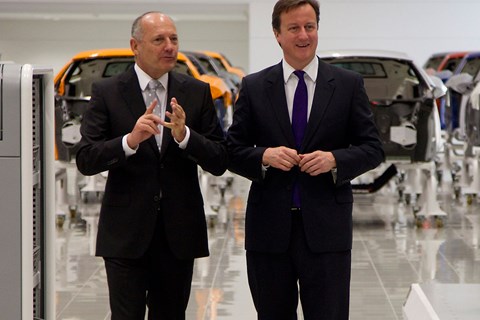► McLaren’s sales numbers in detail
► Ron is gone and Brexit looms
► What happens next?
McLaren Automotive delivered a ‘once in a lifetime’ achivement in 2016 – it doubled sales by introducing the 570 Sports Series range, and boosted pre-tax profits by 70%. The day after the cars business announced its financial results, Ron Dennis ended his lifetime with McLaren, selling his stake in the Technology Group and Automotive division.
While that ties up the corporate loose ends created by Dennis’s ousting as chairman and CEO last November, automotive executives looked to the future, speaking candidly about the uncertainty of Bexit and McLaren’s construction of a composites factory that could help double volumes again. Here’s what we learned.
1. 2016 was a gamechanger
McLaren Automotive’s sales jumped by 99%, from 1654 units in 2015 to 3286 last year. The introduction of the third model line, the 540/570 Sports Series, contributed 63% of those sales (2031 units).
Global sales and marketing director Jolyon Nash said of McLaren clinching the double: ‘We don’t anticipate that happening again, it was a once in a lifetime achievement for the business.’ The United States bought the most McLarens – 1139 – outscoring Europe’s 996 cars.
2. Record revenues naturally, but not record pre-tax profits
McLaren Automotive’s revenue from sales jumped to £650m in its sixth year in business; in comparison Lamborghini’s revenues stood at €853m (£750m), having sold 3457 cars in 2016. Ferrari’s highly developed money-making machine is the monster though: €3.1bn in revenues and 8014 cars.
Still, McLaren will be pleased with £65.8m in operating profit, and pre-tax profits rose from £5.4m to £9.2m. That said, the pre-tax figure hit £15m in 2014 – powered by deliveries of the £866,000 P1 ultimate McLaren.
3. What’s McLaren’s plan to keep growing?
That’ll be the Track22 strategy, promising 15 new models by 2022. The first two are the 720S Super Series and fourth Sports Series variant, the 570S Spider. ‘We’ve taken 1500 orders for the 720S; it’s sold out for this year and into next year,’ said CEO Mike Flewitt (pictured below). The boss reckons McLaren will target the 4000 sales mark this year, and pass the 5000 barrier by the end of the decade.

Interestingly, chief financial officer Paul Buddin confirmed that the Composites Technology Centre, the carbonfibre tub r&d centre under construction in Sheffield, will have a capacity of 10,000 units. ‘It’s not a big cost differential to put in extra capacity in to give us future flexibility,’ he said. Buddin wouldn’t be drawn on whether all that headroom would be used by McLaren – or whether a third party such as BMW could tap into it for a new supercar.
4. Time for theme parks and Mc-underpants to boost profits?
Buddin describes car sales as the Tier 1 profit generator, with aftersales and McLaren Special Operations making up Tier 2. MSO, with its individualisation programme, special editions and work servicing heritage cars including some 40 F1s, doubled its revenues. And the parts business will continue to grow, as McLaren strives to hit 10,000 cars on the road by late 2019, and as customer racing expands.
5. Brexit could throw an enormous spanner in the works
‘For us and all businesses it means uncertainty,’ said finance chief Paul Buddin (pictured below). Naturally today’s weak pound inflates the cost of parts in euros and dollars (though makes US sales more profitable), the prospect of tariffs is catastrophic, and immigrant quotas could affect recruitment.

‘We are looking for the political leadership to deliver a competitive environment post Brexit,’ explained Buddin. ‘As a company we support free trade. And we want the UK to continue to influence the regulatory environment.’ On CO2 rules for example, McLaren has special dispensation as a small manufacturer, having to deliver a percentage decrease in fleet carbon emissions rather than hit the 95g/km of CO2 average by 2021. Post-Brexit, the UK could be free to introduce its own automotive regulations, adding complexity for car makers. ‘We have to plan our product and technology some time ahead,’ rued the finance chief.
6. And finally, Ron is gone
After 35 years building McLaren from an also-ran Formula 1 team into a global technology company, Ron Dennis has stood down as chairman. Majority shareholder Mumtalakat Holdings of Bahrain and Mansour Ojjeh of the TAG Group are buying him out, after a disagreement with Dennis (pictured below with another bloke ousted from a position of power) over corporate strategy forced him out of the company.
McLaren is reorganising itself as the McLaren Group, which will continue to run its interests in Formula 1 and high-tech control systems, interrogating big data from motorsport and healthcare suppliers. And, of course, car making, which will keep striving for the next set of growth figures.
